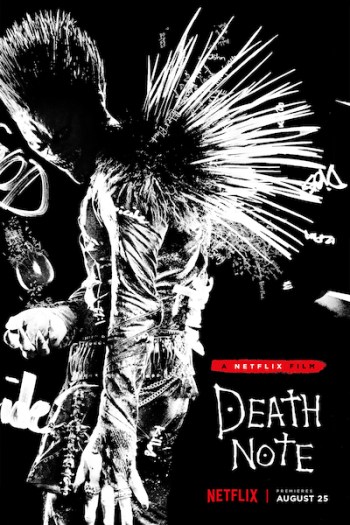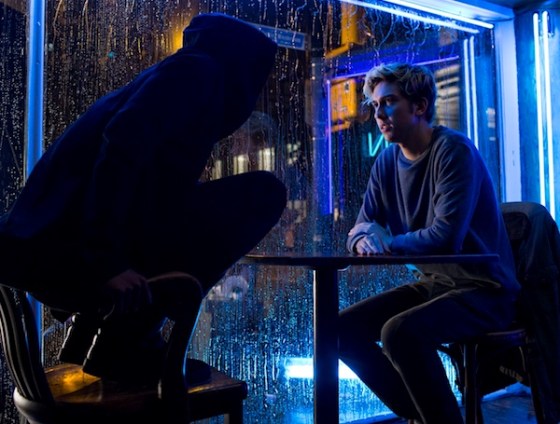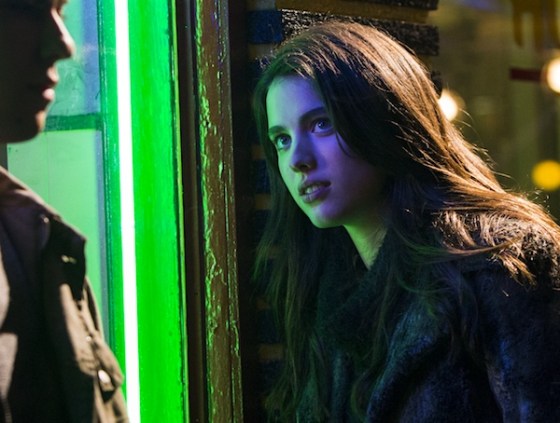Adam Wingard | 100 mins | streaming (UHD) | 2.35:1 | USA / English | 18

Something of a global phenomenon in the ’00s, Death Note started life as a manga, is perhaps best known for its anime adaptation, was adapted into a series of live-action films (I reviewed the first two last week), adapted again as a live-action TV series, and was even turned into a musical. Although it’s taken a while, finally the inevitable is here: an American remake. After passing through several studios, it’s wound up with Netflix, under the helmsmanship of Adam Wingard. Thus, I was hoping for the new film from the director of The Guest. Instead, I got the new film from the director of Blair Witch. And much like Blair Witch, this is a ham-fisted reimagining of a once-popular franchise.
This incarnation of the story concerns Light Turner (Nat Wolff), a Seattle high school student who one day discovers the mysterious Death Note, a notebook with the power to kill just by writing someone’s name in it. Goaded into using it by the demonic death-god Ryuk (voiced by Willem Dafoe), Light soon teams up with his crush Mia (Margaret Qualley) and they set about murdering criminals. Their actions become famous under the alias Kira, which they hope to use to establish a new world order. But hot on the case is a mysterious super detective known only as L (Lakeith Stanfield), who engages Kira in a battle of wits.
As with so many things nowadays, the US version of Death Note has been dogged by accusations of whitewashing. As seems to be the case at least half the time, these accusations are largely unfounded. If this had kept the Japanese settings and character names but given them white faces, fair enough, but it hasn’t — it’s relocated to America, with American characters. It’s no different to all the other new-country remakes that have always happened (and also goes on the other way, with US movies remade in Bollywood and Asia, we just don’t hear about them very often here).

Unfortunately, Death Note: America has genuine problems to contend with. Despite that reimagining status, it’s still understandably shackled to the broad shape of the original work. Consequently, it glosses over some of the more interesting implications of the premise in its rush to make Kira famous and introduce L. Partly that’s what happens when you condense so much story into just 100 minutes, but it’s also because it’s beholden to bringing in L and starting his cat-and-mouse game with Light. When I reviewed the Japanese live-action movies, I didn’t think Light and L’s battle of wits was as clever as the films clearly thought they were, and it’s even worse here.
There would seem to be more fertile and interesting ground for exploration in why Light and Mia are trying to establish a new world order — what exactly they think that means; what motivates them to do it; and how they intend to achieve it. On the whole, the film doesn’t seem to be making time to dig into the psyche of its characters — why they’re doing what they’re doing, how it changes them — instead just going through the motions of a thriller plot. It feels like it’s had 20 minutes of character stuff cut out that would grease the wheels of the plot. The worst offender is the climax: there’s no weight to the big finale because we’ve been given no time to care about these characters or their relationships with each other.

For all the faults of the way the other version I’ve seen executed Light and L’s chess-like interactions, at least they consistently involved Light using the Death Note and its rules to try to trick L. Here, after the eponymous book and its abilities have been established, it’s basically just used to control other people to make them forward the plot, only returning to its real purpose come the climax. This is another reason the focus on Light and L’s duelling doesn’t work here: at least the original thought they were both geniuses and behaved as thus; each of them was motivated by proving they were cleverer than the other, everything and everyone else be damned. Here, L is still some kind of savant, whereas Light seems a pretty normal teenager, motivated by… well…
So, in the original, Light does his utmost to keep the Death Note secret from everyone to protect his identity as its user. Here, almost as soon as he’s got it he blabs about it to the girl he fancies. Why? Same reason most guys try to show off to girls: because he thinks it’ll impress her. It’s a change of motivation, but okay, why not? But he’s given very little indication that such a thing would impress her. What if she’d been appalled and gone running to the police? She doesn’t, of course, because this is a geek’s fantasy, so she a) loves it, and b) within minutes is shagging him. (Presumably. This may be an 18 for gore, but sexy times are implied by no more than a little light clothing removal. Perhaps they just sat around in their undies while murdering people with their magic book, I dunno.)

Believe it or not, Death Note is not a total washout. Indeed, the best things about the film are easily identified. Firstly, there’s Willem Dafoe’s voice performance as Ryuk. If you need a manipulative death-god, he’s a perfect choice. Secondly, the visual realisation of said death-god, a mix of strong CG and keeping him in the shadows. It’s light years more effective than the ’00s movies. On the downside, Ryuk’s role amounts to little more than a glorified cameo: after an initial appearance to explain the rules, he just pops up briefly to remind us he’s still a bother.
Thirdly, then, there’s the death sequences that occur on the first couple of occassions Light uses the Death Note. This film skips the “they just die of a heart attack” phase and goes straight for the “you can dictate how they die” jugular. In this version, that means a Final Destination-a-like chain of random events occur that make the deaths fairly amusing. Also, graphically violent — enough for that 18 in the eyes of the BBFC. These go AWOL again as the film has to get busy with its plot, which is a shame. Basically, someone should’ve tapped Wingard to make Final Destination 6.
Fourthly, and finally, the score is very likeable. It’s full of the ’80s horror movie synths you’d expect from the director of The Guest, though it’s undercut somewhat by a few bizarre song choices, mostly during the climax.

Having read a few reactions to the film online, it strikes me that on one hand you’ve got fans criticising it for not being faithful enough, while on the other you’ve got critics picking on it for things that I’d argue are inherent in the source narrative (at least based on what I’ve seen before). That doesn’t excuse this adaptation entirely — they’ve changed so much that fixing logic issues could definitely have happened too — but it’s an amusing juxtaposition of reasons for displeasure: it’s a film scuppered both by being faithful and by not being faithful. Unfortunately that means that, whether you’re comparing it to a previous version or not, it fails to be a coherent experience.

Death Note is available worldwide on Netflix now.
